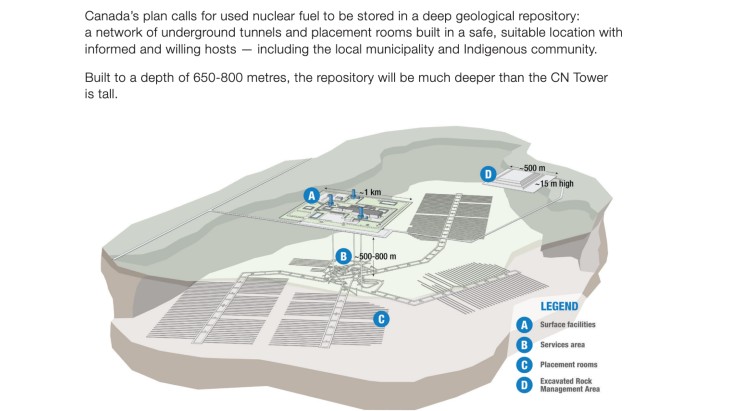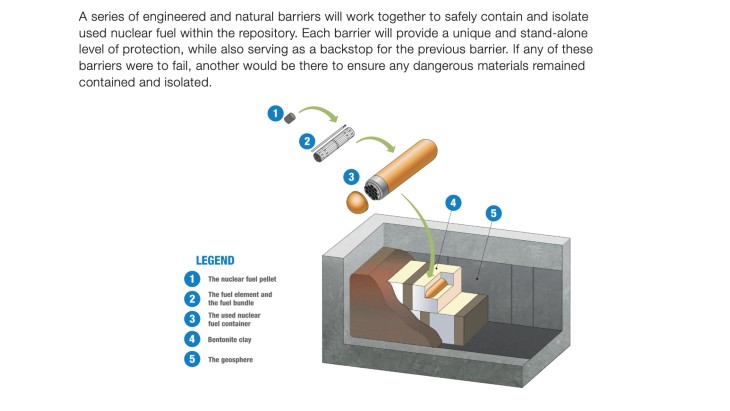"This is a historic moment," Nuclear Waste Management Organization President and CEO Laurie Swami said. "This project will solve an environmental issue and supports Canada's climate change goals. And today's decision was driven by a consent-based siting process led by Canadians and Indigenous peoples. This is what making history looks like."
The Nuclear Waste Management Organization (NWMO) said the announcement was an important milestone in delivering on its promise to not leave Canada's used fuel as a burden for future generations to manage. There is international scientific consensus that a deep geological repository is the safest way to manage used nuclear fuel over the long term, and Canada is among the leading countries in implementing this solution, the organisation said.
Launched in 2010, the NWMO's community-driven, consent-based site selection process included clear commitments that the plan could only move forward in an area with a site that meets rigorous safety standards and has "informed and willing" hosts. By 2019, the initial list of 22 communities that had expressed an interest in learning about the project and exploring their potential to host it had been narrowed down to two, both in Ontario: the Wabigoon Lake Ojibway Nation-Township of Ignace area and the Saugeen Ojibway Nation-South Bruce area.
Earlier this month, members of Wabigoon Lake Ojibway Nation indicated their willingness to move forward with the process. The Township of Ignace confirmed its willingness to proceed in July, following a community vote.
"This important decision for Canada was possible because of the communities' leadership and active engagement over a decade of learning, as well as considering the future of their communities," NWMO said. "The safety of the site was also established through rigorous site assessment and technical studies."

There has been widescale public information and consultation over the plans (Image: NWMO)
The project will now move forward to the regulatory decision-making process. The NWMO has agreed to an Indigenous-led Regulatory Assessment and Approval Process, a sovereign regulatory process that will be developed and implemented by Wabigoon Lake Ojibway Nation to ensure that potential impacts of the project are assessed against Wabigoon Lake Ojibway Nation's Anishinaabe values, and that conditions to mitigate any impacts are designed by Wabigoon Lake Ojibway Nation and complied with by the NWMO. The project will also undergo the regulatory decision-making processes of the Canadian Nuclear Safety Commission and through the Government of Canada's impact assessment process.
Wabigoon Lake Ojibway Nation Chief Clayton Wetelainen said the nation views its role as the potential host for Canada’s used nuclear fuel as "one of the most important responsibilities of our time".
"This project will be under intense scrutiny by our Nation’s regulatory process in addition to the regulatory oversight by the Impact Assessment Agency of Canada and the CNSC," he said. "Wabigoon will ensure that safety, environmental protection and Anishnaabe values are upheld throughout this process," he added.
Township of Ignace Mayor Kim Baigrie expressed her gratitude to the Wabigoon Lake Ojibway Nation and Ignace communities and the other communities that were involved in the site selection process, for their leadership and engagement, and commended the NWMO for its progress in advancing a "safe, responsible and informed" plan. "Thanks to our commitment to health and safety, Canadian nuclear energy will continue to power communities at home and allies around the world - providing Canadians jobs and opportunities for generations," she said.
Ontario’s Minister of Energy and Electrification Stephen Lecce thanked the leaders of Wabigoon Lake Ojibway Nation and the Township of Ignace for their leadership and willingness to host the project. "As our government expands our zero-emissions nuclear fleet to meet rising energy demand, Ontario is cementing its position as a world leader in all parts of the nuclear lifecycle – this achievement by NWMO is just the latest example," he said.
How will the deep geological repository work?
Canada's used nuclear fuel is currently in interim storage at reactor and laboratory sites. NWMO's project timeline envisages construction of the repository - which will be more than 600 metres below ground and have an underground footprint of about 2 kilometres by 3 kilometres - beginning in around 2033, subject to being granted the necessary licences. Operations of the repository - which will use a series of engineered and natural barriers that work together to contain and isolate used nuclear fuel - are expected to begin in 2040-2045.


(Images: NWMO)





_30199.jpg)
_72306.jpg)

_49562.jpg)





